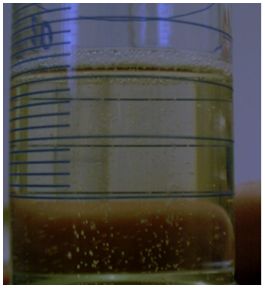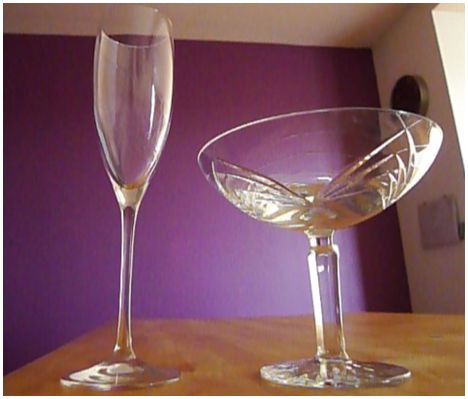- Home
- Varying factors
Varying factors
Several factors can influence the taste of champagne
Firstly, the material of the containers that can be separated into two categories:
- - Hydrophilic materials (glass and crystal) seek contact with water / aqueous liquid and therefore only have sufficient energy for weak non-classical heterogeneous nucleation ;
- - Hydrophobic materials (plastic) avoid contact with water by all possible means. They release a sufficient amount of energy for conventional heterogeneous nucleation to take place and the bubbles created then protect them from contact with water.
Here are the results obtained after having carried out the experiment.


Plastic Glass
A second factor that influences the taste is the shape of the container, that is to say, the differences between a flute and a glass of champagne.
The glass provides a large surface in contact with the open air: degassing, due to free diffusion, occurs more readily but to the detriment of the bubbles, that are thus less numerous than in a flute. In addition, the glass is not as high as a flute, which leaves little time for the bubbles to swell and be visible to the admiring naked eye.
The flute, on the contrary, provides a relatively small area in contact with the open air, allowing the champagne to keep the CO2 longer and therefore to have more bubbles. In addition, a flute has an average height of 10 cm, leaving a long time interval for the bubbles to swell and therefore provides a much more refined aesthetic result than that of the glass. However, fashion changes and so do champagne glasses!

A third factor we studied is the inclination of the champagne flute while the champagne is being poured. Indeed, we can observe that if the champagne is served perpendicular to the flute, a large amount of foam appears, whereas if the flute is inclined very little foam is formed. Obviously, a scientific explanation exists: the amount of CO2 that escapes during service depends on the inclination of the flute. We wanted to set up an experiment to prove this, but it required the use of an infrared camera, a camera that our high school unfortunately doesn't have. We therefore used the results obtained by Mr. Liger-Belair.

The bluer the gas, the higher the concentration of CO2
In these images, we can see that the amount of CO2 escaping is greater when the flute is upright: the foam formed is therefore more important.
We then studied a fourth factor, the temperature. As previously stated, the ideal temperature for serving champagne is 9°C. However, the difficulty of defining an “ideal” temperature lies in the fact that the temperature is responsible for two phenomena: the higher the temperature, the larger the bubbles but the colder the champagne the less flavour it has. The "ideal" temperature is when you obtain small delicate bubbles (large bubbles are not pleasant to taste) yet also preserve as many aromas as possible. This balance is obtained between 8 and 10 ° C in normal tasting conditions.
The last factor that we studied is atmospheric pressure. This factor is different to the others because we cannot influence it. When the pressure decreases, that is to say when the champagne is in high altitude, the volume of the bubbles increases. On the contrary, the volume decreases when the pressure increases.
We also did an experiment to see if the presence of alcohol has an impact on bubbles. Therefore, we compared champagne and a sparkling grape juice but we didn’t observe any difference. Yet, we did it with the naked eye, so we decided to sit on the fence.

